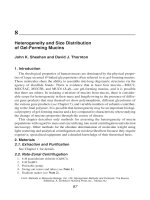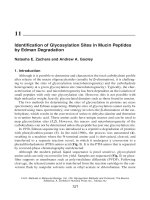Glycoprotein methods protocols - biotechnology 048-9-261-271.pdf
Bạn đang xem bản rút gọn của tài liệu. Xem và tải ngay bản đầy đủ của tài liệu tại đây (114.41 KB, 11 trang )
Inhibition of Glycosylation of Mucin 261
261
22
Inhibition of Mucin Glycosylation
Guillemette Huet, Philippe Delannoy, Thécla Lesuffleur,
Sylviane Hennebicq, and Pierre Degand
1. Introduction
Mucins are secreted or membrane-bound large glycoproteins produced by epithe-
lial cells of normal and malignant tissues. The secreted mucins are the major compo-
nents of the mucous gel overlaying respiratory, gastrointestinal, or genital epithelia.
Mucins constitute a family of extensively O-glycosylated glycoproteins (40–80% by
weight) (1,2) encoded by a family of different MUC genes (3). The oligosaccharide
side chains substitute threonine or serine residues of tandemly repeated sequences in
the core of the molecule.
The biochemical properties and functions of mucins are greatly dependent on their
O-glycosylation state. In particular, mucins can display a role in cellular protection or
cellular adhesion (4). On the one hand, filamentous mucins highly substituted by nega-
tively charged O-glycans act as a protective barrier for epithelial cells. On the other
hand, the terminal oligosaccharides of mucins can interact with cellular or bacterial
receptors and promote adhesion on the epithelial cells. Mucins display tissue-specific
patterns of O-glycosylation. Alterations in the glycosylation of mucins commonly
occur in many mucosal diseases. In particular, glycan epitopes of mucins are impor-
tant markers in cancer (5,6).
Studies on the regulation of the biosynthesis and secretion of mucins have been
improved by the use of human mucosal cells, which can be grown in long-term
culture (7). To address the function of carbohydrates, inhibitors of O-glycosylation
have been used in in vivo experiments on cultured cells (8). For that purpose, aryl-
N-acetyl-α-galactosaminides (GalNAcα-O-aryls) have been initially used as
potential competitors of the glycosylation of N-acetylgalactosamine (GalNAc)
residues linked to the core protein, since these sugar analogs were suitable substrates
From:
Methods in Molecular Biology, Vol. 125: Glycoprotein Methods and Protocols: The Mucins
Edited by: A. Corfield © Humana Press Inc., Totowa, NJ
262 Huet et al.
for UDP-GlcNAc:GalNAc-Rβ1, 3-N-acetylglucosaminyltransferase (9). Actually, in
in vitro experiments, these compounds inhibit the UDP-Gal:GalNAc-Rβ1,3-galac-
tosyltransferase (8). GalNAcα-O-aryls (benzyl-, phenyl-, and p-nitrophenyl deriva-
tives of N-acetylgalactosamine), when added in the medium of cultured cells, are
metabolized within the cells and give rise to different internal derivatives. In vivo the
resulting effects of GalNAcα-O-aryls on the O-glycosylation of mucins are different
from the effects obtained in vitro (8,10–12). In this way, in mucin-secreting colon
cancer cells such as the HM7 variant of LSI74T cells (8,10) and the HT-29 MTX
subpopulation (11,12), GalNAcα-O-aryls are highly converted into the disaccharide
Galβ1-3GalNAcα-O-aryls, but this conversion does not impair some significant β1,3-
galactosylation of O-linked GalNAc to the core protein as well. The disaccharide-
formed Galβ1-3GalNAcα-O–aryls have proved, on the contrary, to behave as a strong
competitive inhibitor of the elongation of the mucin Galβ1-3GalNAcα sequences by
N-acetylglucosa-minyltransferases, sialyltransferases, and fucosyltransferases (8,10–12).
Hence, in in vivo experiments, GalNAcα-O-aryls mainly act as inhibitors of the elonga-
tion of the Galβ1-3GalNAcα sequence (T-antigen) of mucins.
The carbohydrate changes induced by GalNAcα-O-aryl treatments can be evaluated by
different methods:
1. Mucins can be directly analyzed in the cell culture media or in the cell lysates by Western
blotting using lectins and/or antibodies directed against carbohydrate epitopes.
2. Mucins can be isolated from cell lysates or culture media by the conventional procedures
using ultracentrifugation on a cesium bromide gradient (13,14), and analyzed by carbo-
hydrate composition or by (enzyme-linked immunosorbent assay (ELISA) with lectins
and/or glycan epitope-specific antibodies.
The effects on mucin secretion can be estimated using metabolic labeling with
[
3
H]threonine or by histochemical staining. And, the intracellular metabolization of
GalNAcα-O-aryls can be studied using metabolic labeling with [
3
H]galactose and
reversed-phase, high-performance liquid chromatography (HPLC).
2. Materials
1. Alcian blue (AB), pH 2.5: 0.1% (w/v) AB in 3% (v/v) acetic acid, pH 2.5.
2. Amplify (Amersham, Buchler Gmbh, Braunschweig, Germany).
3. Anti-digoxygenin (DIG) Fab fragment conjugated with alkaline phosphatase (Boehringer
Mannheim, Germany).
4. Aryl-N-acetyl-α=D=galactosaminides (Sigma, St. Louis, MD).
5. Blocking solutions:
a. Blocking solution 1: Tris-buffered saline (TBS), pH 7.5, containing 2% polyvinyl
pyrrolidone K-30 (Aldrich).
b. Blocking solution 2: TBS, pH 7.5, containing 0.5% blocking reagent (Boehringer
Mannheim). Heat at 60°C for 1 h.
c. Blocking solution 3: TBS, pH 7.5, containing 6% bovine serum albumin (BSA).
d. Blocking solution 4: 0.01 M phosphate-buffered saline (PBS), pH 6.8, containing 1%
(w/v) BSA.
Inhibition of Glycosylation of Mucin 263
6. Blotting buffers:
a. Anode buffer: 0.3 M Tris HCl, pH 10.4, containing 20% methanol.
b. Cathode buffer: 0.04 M 6-amino-N-hexanoic acid containing 20% methanol.
7. Cell disrupter Sonifer B-30 adapted with an exponential probe (Branson Sonic
Power).
8. Continous flow radiochromatography detector Flo-One/Beta.
9. ECL detection kit (Amersham).
10. Eukitt (Kindler GMBN, Freeburg, Germany).
11. Hibar prepacked column RT 250-4, Lichrosorb RP-18, 5 µm (Merck, Darmstadt,
Germany).
12. Incubation buffer:
a. Incubation buffer 1: TBS, pH 7.5 containing 1% (w/v) BSA, 1% sodium dodecyl
sulfate (SDS), 1% Triton X-100, 10% fetal calf serum (FCS).
b. Incubation buffer 2: TBS, pH 7.5 containing 10% FCS.
13. Labeling :
a. [
3
H]-
L
-threonine (ICN, Costa Mesa, CA) 46 Ci/mmol, 1.7 GBq/mmol (50 mCi/mL).
b.
D
-[6–
3
H]galactose (Amersham): 20–40 Ci/mmol, 0.7–1.5 TBq/mmol (1 mCi/mL).
14. Lectin buffer: TBS, pH 7.5, containing 1 mM MgCl
2
, 1 mM MnCl
2,
and 1 mM CaCl
2
.
15. Cell culture media:
a. Standard growth medium: Dulbecco’s modified Eagle’s medium containing 2 mM
glutamine, 100 UmL of penicillin, 100 mg µL of streptomycin, and 10% fetal bovine
serum.
b. Growth medium with GalNAcα-O-aryl: The medium in ituma is added with aryl-N-
acetyl-α-
D
-galactosaminide.
c. Threonine-free medium (Life Technologies).
d. Low-glucose Dulbecco’s minimal essential/H-16 medium (Gibco).
16. Molecular weight-markers are the high molecular range weight of Rainbow colored mark-
ers (Amersham), maximun 200 kDa (myosin).
17. Monoclonal anti-T (Thomsen-Friedenrich) antibody available from commercial suppliers.
18. Nuclear Red: 0.1% (w/v) nuclear red in 5% aluminum sulfate solution. Heat to dissolve
and filter.
19. Paraformaldehyde: 4% (w/v) in 0.1M phosphate buffer, pH 7.4.
20. PBS:
a. 0.01 M PBS, pH 6.8.
b. 0.01 M PBS, pH 6.8, containing 0.1% (v/v) Tween-20.
21. Peroxidase-labeled antimouse IgG antibody (Jackson Immunoresearch Laboratories, West
Grove, PA).
22. Peroxidase-labeled streptavidin.
23. RIPA buffer: 1 mM Tris-HCl, pH 8.0, 0.01 M NaCl, 0.1% SDS, 1% Triton X-100,
0.5% sodium deoxycholate, 1% phenylmethylsulfonylfluoride, 1 mM sodium ethylene
diaminetetraacetate.
24. Stop solution: 1 N HCl.
25. Substrates:
a. Substrate solution 1: 50 µL of 4-nitroblue tetrazolium chloride (77 mg mL in 70%
dimethylformamide) and 37.5 µL of 5-bromo-4-chloro-3-indolyl-phosphate (50 mg
mL in dimethylformamide) in 10 mL of 100 mM Tris-HCl, pH 9.5, 50 mM
MgCl
2
, and 100 mM NaCl.
264 Huet et al.
b. Substrate solution 2: 1 × 10 mg tablet of O-phenylenediamine dihydrochloride (Sigma)
in 10 mL of 0.01 M PBS, pH 5.5. Add 15 µL of 30% hydrogen peroxide immediately
before use.
26. TBS: 50 mM Tris-HCl, 150 mM sodium chloride, pH 7.5.
27. X-O Kodak films (Amersham).
28. Whatman 3MM paper.
29. SDS-polyacrylamide gels for electrophoresis: stacking gels of 2% and running gels of
2–10% polyacrylamide gradient gel (acrylamide/bisacrylamide ratio of 37.5) are prepared
at 2-mm thickness.
3. Methods
3.1. Cell Culture in the Presence of GalNAc
α
-O-benzyl
3.1.1. Conditions of Use of GalNAc
α
-O-benzyl
GalNAcα-O-benzyl is directly dissolved in the culture medium for 2 h at room
temperature with continuous stirring. Then, the medium is sterilized by filtration.
GalNAcα-O-benzyl may be used at various concentrations up to 10 mM. A range of
different concentrations should be tested for the viability of the cells and the obtained
effects. Indeed, the response is expected to be different according to the cell type, and in
particular, its glycosyltransferase pattern.
GalNAcα-O-benzyl can be used in the following ways:
1. In a short treatment over a 24-h period. The cells are cultured in the standard medium up
to their differentiation state into mucin-secreting phenotype, and then for 24 h in the
medium enriched in GalNAcα-O-benzyl.
2. In a long time period treatment. The cells are cultured in the standard medium up to d 2
after seeding, and then in the medium enriched in GalNAcα-O-benzyl. The medium is
changed daily with new medium containing GalNAcα-O-benzyl.
3.1.2. Metabolic Labeling
To study the effects of GalNAcα-O-benzyl on the secretion of mucins, cells are
seeded on 6-well plates. For metabolic labeling with [
3
H]Threonine, the current
medium is substituted by threonine-free medium. [
3
H]Threonine (50 µCi mL) is
added in the threonine-free medium of control cells and in the threonine-free
medium containing GalNAcα-O-benzyl of treated cells. Then, the culture media are
collected and centrifuged and the cells are lysed in 1 mL of RIPA buffer and centri-
fuged. The supernatants are analyzed on 2–10% gels and autoradiography (see
Subheading 3.2.4.).
To study the intracellular metabolism of GalNAcα-O-benzyl, cells are seeded into
6-well culture plates. For metabolic labeling with [6–
3
H]galactose, the current medium
is substituted by low glucose medium to facilitate the incorporation of the precursor.
[6–
3
H]Galactose (1 mCi mL) is added in the medium simultaneously with GalNAcα-
O-benzyl for up to 72 h. After removing the culture media, cells are lysed by sonica-
tion in 1 mL of distilled water and centrifuged at 13,000g. The supernatants are
collected, heat-denaturated, and filtered through 0.22 µm ultrafiltration units.
Inhibition of Glycosylation of Mucin 265
GalNAcα-O-benzyl derivatives are analyzed by reversed-phase HPLC using a
Lichrosorb RP-18 column.
3.2. Visualization of Mucins after Electrophoresis
Samples of culture media or cell lysates are subjected to electrophoresis on
2–10% polyacrylamide gels in the presence of SDS.
3.2.1. Transfer to Nitrocellulose
Proteins are transferred from the gel to nitrocellulose for 1 h using a semi-dry
electroblot apparatus. Six sheets of Whatman 3MM paper are immersed in the anode
buffer and covered with the membrane and then with the gel, both previously rinsed in
the anode buffer. The gel is then covered with six more sheets of Whatman 3MM
paper that have been immersed in the cathode buffer. The transfer is carried out at
0.8 mA/cm
2
.
3.2.2. Lectin Staining (
see
Notes 1–4)
All steps should be performed at room temperature with gentle shaking except the
color development.
1. Wash the membrane three times in TBS for 5 min.
2. Incubate in blocking solution 1 for 2 h (see Note 1).
3. Wash the membrane three times in TBS for 5 min.
4. Incubate with DIG-labeled lectin (see Note 2) in lectin buffer for 1 h (see Note 3).
5. Wash the membrane in TBS (three times for 5 min).
6. Incubate in blocking solution 2 for 1 h.
7. Wash the membrane in TBS (three times for 5 min).
8. Incubate with anti-DIG Fab fragment conjugated with alkaline-phosphatase diluted 1000-
fold in TBS (1 µg mL).
9. Wash the membrane in TBS (three times for 5 min).
10. Incubate the membrane in substrate solution 1 until color development (see Note 4).
11. Stop the reaction by immersion and gentle shaking in distilled water.
12. Dry the nitrocellulose membrane at room temperature.
3.2.3. Antibody Staining
All steps should be performed with gentle shaking.
1. Wash the membrane in TBS for 15 min.
2. Incubate the membrane in blocking solution 3 for 1 h at 37°C.
3. Wash the membrane twice in TBS containing 0.1% Tween-20 for 15 min.
4. Incubate the membrane at room temperature with the first antibody diluted 1000-fold in
the incubation buffer 1 for 2 h.
5. Wash the membrane in TBS containing 0.1% Tween-20 (two times for 15 min).
6. Incubate the membrane at room temperature with the peroxidase-conjugated second anti-
body diluted 4000-fold in incubation buffer 2 for 2 h.









